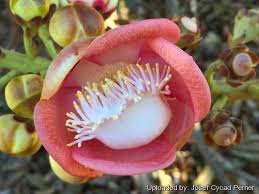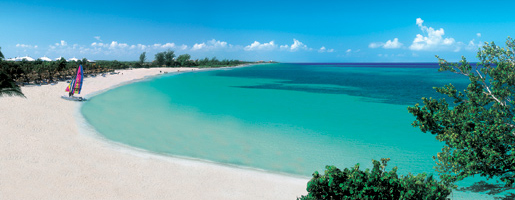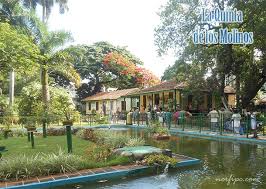LA QUINTA DE LOS MOLINOS, HAVANA. HOME OF “LA MARIPOSA” NATIONAL FLOWER OF CUBA. PHOTOS/VIDEOS.
La Quinta de Los Molinos is a National Monument institution located in Havana, Cuba. The Botanical Garden of Havana and the Máximo Gómez Museum have been located there.
HISTORY
It is called La Quinta de Los Molinos due to the ancient existence of 2 mills used to grind tobacco and obtain snuff, in high demand at the end of the 18th century throughout Europe, and in particular in Spain; which was consumed by placing a little under the nose and absorbing or breathing in the aroma, as well as snuff to smoke in the pipes. The mills were owned by Martín de Aróstegui, president of the Royal Tobacco Factory belonging to the Spanish king, hence its name.
https://youtu.be/CKqucOiY1Rw
Press ^ here
QUINTA DE LOS MOLINOS, LA HAVANA, CUBA (VIDEO)
These mills operated until the second half of the 19th century and were moved by the force of the water from the so-called Zanja Real, which was the first aqueduct that Havana had. Its construction began in 1592, and it was finished after 27 years of work.
The original extension of the farm far exceeded the current territory, as it extended to the north to approximately the location of the University, to the northwest to the current Calixto García Hospital, originally founded under the name of Alfonso VIII in 1896; to the west to the current G street including the Castillo del Príncipe, to the south to Avenida Carlos III and to the east to Infanta street.
FOUNDATION OF THE BOTANICAL GARDEN OF HAVANA
When the Molinos del Rey disappeared, the Botanical Garden of Havana was founded in this place, along with the construction of the rest house of the General Captains, which was moved from the area that currently comprises the Park of the American Fraternity and the south wing of the National Capitol where the first botanical garden had been founded in 1817.
https://youtu.be/-CV8X7i87pk
Press ^ Here
QUINTA DE LOS MOLINOS, LA HAVANA, CUBA (VIDEO)
On February 24, 1899, Generalissimo Máximo Gómez, from the central region of the country, entered Havana, and the mayor of the city, Perfecto Lacoste, ordered that the headquarters of the Liberation Army and its General in Chief, were established in the Quinta de los Molinos due to the large extension of the land. There Máximo Gómez was received by a population with excessive enthusiasm that cheered and cheered him as he passed.
In 1906 this garden was inscribed as an important reference site in the World System of Botanical Gardens. In this place, the Hedychium coronarium, called Mariposa, was declared in 1936 as the national flower of Cuba.
At the beginning of the century, the first public school in the area was created, which later, in 1907, became the University of Havana as the Faculty of Agricultural Sciences and Sugar Chemistry.
National Monument since 1981, in the Quinta de Los Molinos, on its grounds, the first Butterfly Garden in Cuba opened for some time, where the public can admire the beauty of the different species and enjoy varied cultural proposals that promote scientific culture and environment and bring visitors closer to nature and its preservation.
THE TREE “CANNON BULLET” (BOLA DE CAÑÓN)
As a curious fact we can say that within the Felipe Poey School, which is within the territory of the Quinta de Los Molinos, there is a tree commonly called ‘Cannonball’ whose scientific name is Couroupita guianensis of the Mirtáceas family.
This tree is extremely rare in Cuba and is native to Costa Rica, Panama, and Brazil. Its flowers are cute and unusual in design, and the fruits are shaped like an ancient cannonball, which is why it is called that. Both the flowers and the fruits hang from the trunk that reaches a great height. In it, one that is part of a forest of more than one hundred specimens of different species was planted and cared for in San Agustín, in the City of Havana, Cuba.
Cuban scientist Juan Tomás Roig y Mesa, called the Wise of the Plants, pointed out that there are few specimens distributed throughout the Island. Our research has found that only five specimens are known in all of Cuba.
LA QUINTA DE LOS MOLINOS, LA HABANA. HOGAR DE “LA MARIPOSA” FLOR NACIONAL DE CUBA
La Quinta de los Molinos es una institución Monumento Nacional situado en La Habana, Cuba. En ella se haya ubicado el Jardín Botánico de La Habana y el Museo Máximo Gómez.
HISTORIA
Es llamado La Quinta de los Molinos debido a la antigua existencia de 2 molinos utilizados para moler tabaco y obtener rapé, de mucha demanda a finales del siglo XVIII en toda Europa, y en particular en España; que se consumía colocando un poco bajo la nariz y absorbiendo o respirando el aroma, así también como picadura de tabaco para fumar en las pipas. Los molinos eran propiedad de Martín de Aróstegui, presidente de la Real Factoría de Tabaco perteneciente al rey español, de ahí su nombre.
https://youtu.be/4SqXJTm2eO0
Presione ^ Aqui
HISTORIA DE LA QUINTA DE LOS MOLINOS (VIDEO)
Estos molinos funcionaron hasta la segunda mitad del siglo XIX y eran movidos por la fuerza del agua de la llamada Zanja Real, que fue el primer acueducto con el que contó La Habana. Su construcción se inició en 1592, y fueron terminados tras 27 años de trabajo.
La extensión original de la quinta superaba en creces al actual territorio, pues se extendía al norte hasta aproximadamente la locación de la Universidad, al noroeste hasta el actual Hospital Calixto García fundado originalmente con el nombre de Alfonso VIII en 1896; al oeste hasta la actual calle G incluyendo el Castillo del Príncipe, al sur hasta la Avenida Carlos III y al este hasta la calle Infanta.
FUNDACION DEL JARDIN BOTANICO DE LA HABANA
Al desaparecer los Molinos del Rey, se fundó en este lugar el Jardín Botánico de la Habana, a la par de la construcción de la casa de descanso de los Capitanes Generales, el cual fue trasladado del área que actualmente comprende el Parque de la Fraternidad Americana y el ala sur del Capitolio Nacional donde se había fundado en 1817 el primer jardín botánico.
El 24 de febrero de 1899 hace su entrada en La Habana el Generalísimo Máximo Gómez, proveniente de la región central del país, y el alcalde de la ciudad, Perfecto Lacoste, dispone que el cuartel general del Ejército Libertador y de su General en Jefe, se establecieran en la Quinta de los Molinos debido a la gran extensión del terreno. Allí Máximo Gómez fue recibido por una población con desmedido entusiasmo que lo vitoreó y lo aclamó a su paso.
En 1906 este jardín fue inscrito como sitio de referencia importante en el Sistema Mundial de Jardines Botánicos. En este lugar fue declarada en el año 1936, la Hedychium coronarium, llamada Mariposa, como flor nacional de Cuba.
A principios de siglo se creó la primera escuela pública de la zona, que pasa más tarde, en 1907, a la Universidad de la Habana como la Facultad de Ciencias Agropecuarias y Química Azucarera.
Monumento Nacional desde 1981, en la Quinta de los Molinos, en sus predios, abrió desde hace un tiempo el primer Mariposario de Cuba, donde el público puede admirar la belleza de las distintas especies y disfrutar de variadas propuestas culturales, que promueven la cultura científica y medioambiental y acercan a los visitantes a la naturaleza y su preservación.
EL ARBOL “BALA DE CAÑÓN”
Como dato curioso podemos decir que dentro de la Escuela Felipe Poey que está dentro del territorio de la Quinta de los Molinos se encuentra un árbol comúnmente llamado ‘Bala de Cañón’ cuyo nombre científico es Couroupita guianensis de la familia de las Mirtáceas.
Este árbol es extremadamente raro en Cuba y es originario de Costa Rica, Panamá y Brasil. Sus flores son lindas y de diseño poco frecuente, y los frutos tienen la forma de una bala de cañón antiguo, por eso se le llama así. Tanto las flores como los frutos cuelgan del tronco que alcanza una gran altura. En ella se sembró y cuidó uno que forma parte de un bosque de más de cien ejemplares de especies diferentes San Agustín, en la Ciudad de La Habana, Cuba.
El científico cubano Juan Tomás Roig y Mesa, llamado el Sabio de las Plantas, señaló que hay pocos ejemplares distribuidos en toda la Isla. Nuestra investigación ha encontrado que se solo se conocen cinco ejemplares en toda Cuba.
Agencies/ Wiki/ Ecured/ Extractos/ Excerpts/ Internet Photos/ YouTube/ Arnoldo VArona/ www.TheCubanHistory.com
THE CUBAN HISTORY, HOLLYWOOD.












